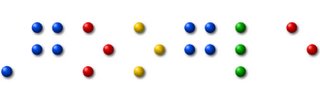 [image and link via Swissmiss]
[image and link via Swissmiss]
Wednesday, January 25, 2006
Coordinating Reading Redux
Behold The Thumb Thing... nifty gizmo for keeping books open. As a notorious perambulatory reader (a tendency that often requires one-handed reading), I for one could use one of these things. And a headlamp to facilitate reading during my walk home from the El after dark.
 [image and link via Swissmiss]
[image and link via Swissmiss]
 [image and link via Swissmiss]
[image and link via Swissmiss]
Hot on the press
Boing Boing informed me that famed tech-book publisher O'Reilly has launched Rough Cuts, a service granting access to books-in-production. Even more interesting (in my estimation) is the ability to shape the written product. From the Roughcuts page:
[Rough Cuts gives] access to an evolving PDF manuscript that you can read, download or print. Once you've purchased a Rough Cuts title, you will have a chance to shape the final product-you can send suggestions, bug fixes, and comments directly to the author and editors.I don't know much about the publishing industry, but this seems a very smart response to encroachments on publishing from the web. It's a way to profit on time-sensitive content (not a bailiwick of print-publishing) and leverage a target-market that is used to being able to contribute its two cents. There's even a nice caveat emptor:
Rough Cuts titles live up to their name-they haven't been fully edited, subjected to final technical review, or formatted for print. In other words, they'll be very current, but they won't be pretty.
Monday, January 16, 2006
Coordinating Reading
Dr. B recently blogged about nifty print-your own bookmarks. What I like best about them is the inclusion of a Note feature. I frequently just use small pieces of blank paper so I can jot down notes while I read (provided I don't own the book in which case I write all over the thing). For fiction, I sometimes need reminders of character names (especially when I've only got time to pick up the book twice a week and have forgotten everyone). For non fiction, well, I jot down things to blog or look up or just think about. I don't know if I'll use these things (the note space is a little cramped), but they sure are better looking than my usual scrap-paper bookmarks.

[Image from Fabiosirna.com]

[Image from Fabiosirna.com]
Friday, January 13, 2006
On writing together
Earlier this month the New York Times reviewed Aquamind's NoteShare. Fallows does a good job pinpointing the crux of the difficulty of computer supported cooperative work (CSCW) -- simple interface usually means limited functionality while robustness usually means the need for an entire IT department. NoteShare sounds like a comfy balance. Looking forward to the PC version later this year. I'm getting tired of emailing documents and creating Yahoo groups for every conference panel proposal I'm on.
While asynchronous collaboration certainly works for most academic work, there are often times early in the process (identifying the unifying theme of several projects) and late in the process (close-editing of collaboratively-written documents) when synchronous collaboration would be nice.
I seldom sit down at a computer with another person, but in co-authoring an article with Jason Swarts when I was in Raleigh last year, we'd meet in a coffee shop with a laptop and pass it back and forth. Extreme writing, as it were. I found the process extremely rewarding. One of my main concerns about teaching composition is that by having students writing in isolation all the time, they can develop bad habits or at least never see other ways of writing that they themselves might benefit from. They develop a mere knack when learning a craft is the goal.
While asynchronous collaboration certainly works for most academic work, there are often times early in the process (identifying the unifying theme of several projects) and late in the process (close-editing of collaboratively-written documents) when synchronous collaboration would be nice.
I seldom sit down at a computer with another person, but in co-authoring an article with Jason Swarts when I was in Raleigh last year, we'd meet in a coffee shop with a laptop and pass it back and forth. Extreme writing, as it were. I found the process extremely rewarding. One of my main concerns about teaching composition is that by having students writing in isolation all the time, they can develop bad habits or at least never see other ways of writing that they themselves might benefit from. They develop a mere knack when learning a craft is the goal.
Wednesday, January 04, 2006
Happy Birthday Louis Braille
Google honors Louis Braille, the inventor of a system of writing for the blind and visually impaired based on raised dots. The braille system represents a wonderful early example of accessibility well ahead of its time. Here's a great image of someone reading braille. In looking at images of braille, I've noticed that there are different modes of presenting it. This image shows raised-dot-only text. This, however, shows ink on the dots which might help different readers. And this image shows traditional writing printed with the braille text. Finally, there are numerous devices which output digital text into braille. (You can see one in action in one of my favorite movies, Sneakers.)

[image from Google]

[image from Google]
Monday, January 02, 2006
Subscribe to:
Posts (Atom)

